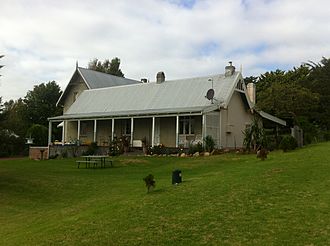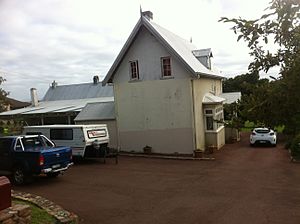Camfield House facts for kids
Quick facts for kids Camfield House |
|
|---|---|

View of Camfield House from the north, 2015
|
|
| General information | |
| Type | Conglomerate of buildings |
| Location | Albany, Western Australia |
| Coordinates | 35°01′11″S 117°52′42″E / 35.0197°S 117.8782°E |
| Type | State Registered Place |
| Designated | 20 September 2002 |
| Reference no. | 17 |
Camfield House, also known as Annesfield, is a group of historic buildings. You can find them in Albany, a town in the Great Southern region of Western Australia.
The property includes a house built in 1852. It was made using a traditional method called wattle and daub. This house was the home of the Camfield family and was also called Annesfield. Another important building on the property is a school. This school was built especially for Aboriginal children.
Contents
Discover Camfield House
Camfield House is more than just a house; it's a collection of buildings with a special history. It shows us how people lived and learned a long time ago in Western Australia. The main house and the school building tell an important story about education and community.
A Special School for Kids
The school at Camfield House started in 1852. It was set up by John Wollaston and Anne Camfield. Their main goal was to provide education for Indigenous children. This was a very important effort at the time.
How the Buildings Look
The main house has a simple, old-fashioned design. It's shaped like a rectangle and has a roof made of corrugated iron that slopes steeply. The walls are covered in a type of plaster called stucco. There are three sets of windows that open outwards, facing the porch. The house also has four chimneys, which are not placed perfectly evenly.
The school building is different. It has two floors and a steeply sloped roof, also made of corrugated iron. One side of the school shows its original brickwork. The other sides are painted white.
The School's Journey
In 1857, the Camfields built a separate school room. This new building had a classroom, a kitchen, and space for up to eight children to live. The school grew quickly. In 1858, there were 23 children attending. By 1868, this number had jumped to 55 students!
However, the school later became less active. Anne Camfield, who worked very hard, was getting older. This made it difficult for her to manage everything.
Protecting History
The buildings at Camfield House are very important. In 1973, the National Trust officially recognized them as significant historical places. This means they are protected so future generations can learn from them. In 2001, they were also added to the local list of important buildings.


